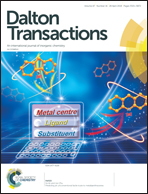Phosphate glasses via coacervation route containing CdFe2O4 nanoparticles: structural, optical and magnetic characterization†
Abstract
CdFe2O4 nanoparticles of around 3.9 nm were synthesized using the coprecipitation method and protected by a silica layer. The nanoparticles were mixed with a coacervate and transformed into phosphate glasses with 1, 4 and 8% in mass of nanoparticles by the melt-quenching method. TEM images confirm that the nanoparticles were successfully incorporated into the matrix without inducing crystallization. 31P NMR and Raman spectral analyses show that new P–O–Si bonds are formed in the glasses containing nanoparticles. The glass transition increases as a function of the nanoparticle content due to an increase in the connectivity of the phosphate glass chains. The UV-Vis spectra show bands at 415 and 520 nm assigned to Fe3+ ions and at 1025 nm, characteristic of Fe2+ ions, indicating that some of the nanoparticles dissolve during the melting process. The sample with 8% CdFe2O4 presents a paramagnetic behavior. The glasses obtained are transparent, non-hygroscopic and possess enormous thermal stability which is important for the production of optical devices.



 Please wait while we load your content...
Please wait while we load your content...